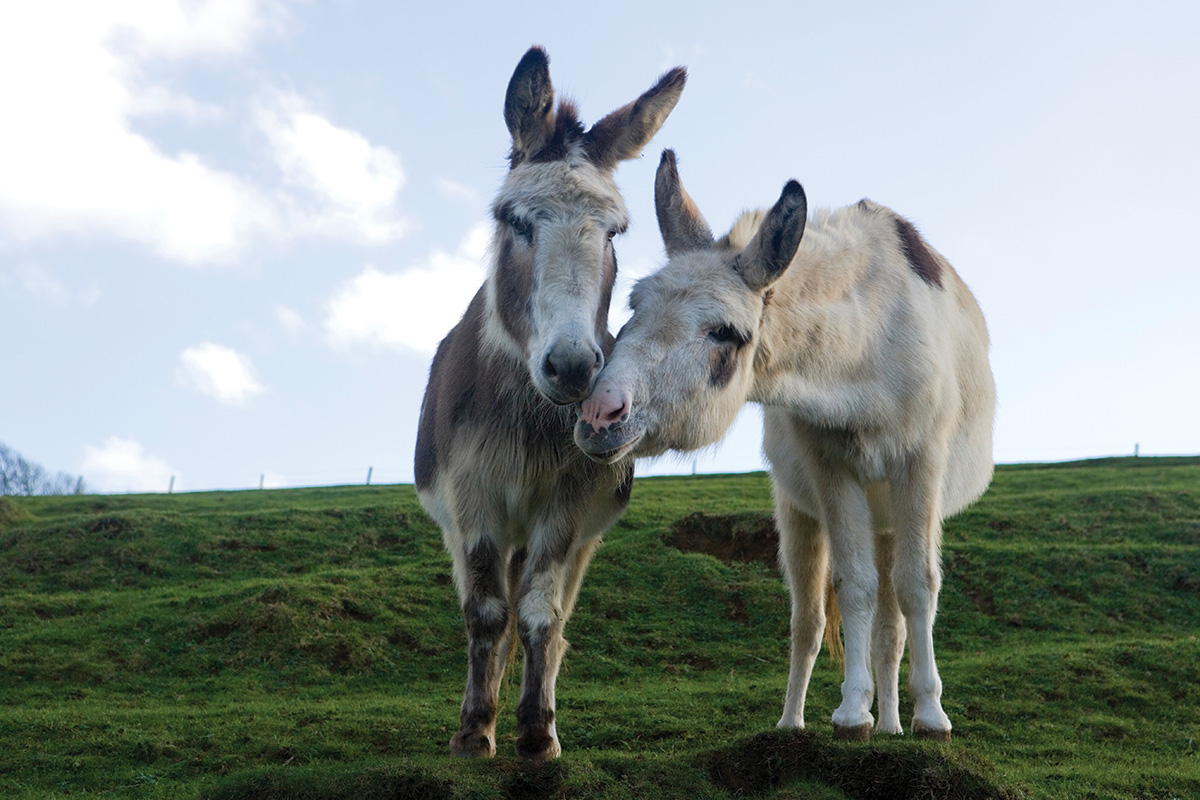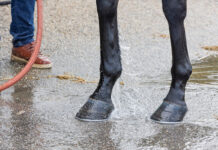
As donkeys grow in popularity as pasture companions, livestock guardians and pets, it’s essential that current and prospective owners understand their basic care. This is especially important when it comes to nutrition—an area where donkeys differ dramatically from horses.
Different Personalities than Horses

One of the greatest differences between horses and donkeys is their mindset regarding anything new. Horses react; donkeys think it through.
“If you want an animal who takes orders, a donkey is not a good choice; if you want a companion, a donkey is a good choice,” says Cindy Benson, who has been breeding miniature donkeys for the last 30 years.
“Miniature donkey is a breed; Mediterranean or Sicilian is descriptive of the same animal,” explains Benson, whose Benson Ranch is located in Gold Hill, Ore. “Mini donkeys are like a cross between a Labrador and a kindergartener; they’re more like dogs than horses. They never outgrow their ‘foal behaviors,’ so they act more like baby animals for life, which makes them good pets.”
Ask anyone what word they first associate with “donkey,” and it’s probably “stubborn.” However, this is a misleading stereotype.
“It’s a misnomer that donkeys are stubborn; that’s their self-preservation drive,” says Kim Elger, Chief Operating Officer for Peaceful Valley Donkey Rescue (PVDR), the largest donkey rescue organization in the U.S. “Getting past that requires trust, which is a huge building block to a relationship with a donkey. Once you get to that point, they are loving, affectionate and easily trained. They love their people. They are man’s other best friend. Like dogs, they want to be a helper and supervisor.”
Headquartered in San Angelo, Texas, PVDR has satellite facilities in several states. Since its founding in 2000, the 501(c)3 nonprofit organization has rescued over 13,000 donkeys, both wild and domesticated.
“Donkeys are prey animals and have one of the highest self-preservation drives of any equine,” Elger explains. “They don’t spook like a horse. Their ‘fight or flight’ instinct tends to lean toward fight. They will size you up and won’t run from you, but they defend themselves if need be.”
Bring Home a Pair

Both Benson and Elger emphasize the importance of not having a solo donkey. For the animal’s sake, you want to have at least two.
“Just having one donkey creates a pushier, bossier animal because they’re socially deprived and needy,” notes Benson.
Donkey Nutritional Needs
Improper feeding is the most common mistakes donkey owners make. If you have a donkey as a companion for a horse, separate them at feeding time.
As descendants of the African wild ass from the arid deserts of Africa, donkeys have lower caloric needs than other equines.
“Obesity kills donkeys faster than anything,” says Benson. “Donkeys are bred to be thrifty and efficient with food.”
Elger agrees.
“They’re used to surviving on scarce resources, and their bodies are conditioned to utilize every bit of food,” she says.
“People tend to assume that donkeys can be fed like horses, so they overindulge with treats or allow too much access to grazing. Donkeys gain weight a lot faster than horses, and obesity will shorten their lifespan.”
Dry lots can be critically important for turnout if you live in an area with plentiful grazing.
“Having a dry lot is one of the best things you can do to prevent donkeys from getting obese,” says Elger. “This allows you to limit the amount of grazing.” She recommends only allowing a few hours of afternoon grazing, since grass sugar is highest in the morning.

Improper feeding can lead to obesity, founder and insulin resistance. Abrupt diet changes and stress can put donkeys at risk of hyperlipaemia, a life-threatening condition occurs when too much fat builds up in the blood, leading to organ failure.
“A protein level below 10 percent is ideal for donkeys,” says Elger. “Suitable hay would be a grass hay, such as Bermuda, coastal, orchard, timothy or brome. Don’t feed alfalfa—the protein can easily exceed 25 percent.”
Feed 2 percent of the donkey’s body weight in hay per day. For a standard donkey weighing 500 pounds, that amounts to 10 pounds of hay daily. For a mini donkey weighing 300 pounds, it’s about 6 pounds.
Because they don’t need a lot of hay, keep donkeys happily chewing by spacing out feedings during the day.
Fresh, cool water should always be available, along with a mineral block.
Although you’ve probably guessed it by now, be sure to skip the grain!
“Feeding grain is overkill; donkeys don’t need this supplementation,” says Elger.

Weight Concerns
The donkey’s crest is the first place you’ll notice weight gain.
“Put your hands on the neck,” says Benson. “A loose, ‘squishy’ crest is healthy. If it’s getting firm or flopping over, that’s [too much] weight gain. It’s not the size of the crest, but how solid it is. Mini donkeys are round by nature, so their bellies won’t tell you they’re overweight.”
Overfed donkeys can also develop fat “pones” (fatty deposits) on their bodies. These deposits won’t go away, even if the diet is corrected.

Watch the Treats
“Manners matter,” says Benson. “If a behavior is not acceptable with a 1,200-pound horse, don’t let your donkey do it either. It’s hard to get a farrier to work with them if they’re pushy and disrespectful.”
Many owners unintentionally encourage pushy behavior with treats.
“Food creates social stress for animals,” Benson continues. “Once you take food out to multiple donkeys, they become competitive, and it increases stress between them. If you come without food and just touch, talk and love on them, it won’t make them competitive with each other. Choose relationships over treats.”
If you must give treats, do so in moderation and one-on-one. Carrots can present a choking hazard because of their shape, so cut them into sticks, not round sections.
Elger uses treats in PVDR’s positive reinforcement training program, but only when working with a single donkey. She feeds low-sugar equine treats or carrots, either shredded or cut into 2-inch sticks.
Donkey Hoof Care
Donkey hoof growth varies between individuals and is affected by age, seasonal changes, living conditions and amount of exercise.
“In the wild, donkeys are walking 7 to 10 miles a day and naturally wearing down their hooves, but this is not the case with the donkey in your backyard,” says Elger.
Generally speaking, for ideal hoof care, donkeys should be trimmed every 8 to 12 weeks. Avoid going longer than 13 weeks between trims.
Vaccinations
Like horses, donkeys should be protected by annual vaccination.
“We recommend vaccinating for eastern and western encephalitis (EEE and WEE), tetanus, rabies, West Nile and rhino,” says Elger. “Talk to your veterinarian about what is recommended in your region.”
Deworming
Internal parasite management is an important part of donkey health care. Your veterinarian can help create an individualized deworming plan.
“Donkeys are more prone to lungworms than other equines, so we recommend using an ivermectin dewormer every six months,” says Elger, adding that fecal testing is helpful for an effective deworming program.
Gelding a DonkeyIf you get a jack (male donkey), castration is recommended, ideally before they’re 1 year old. (Remember, they can not only impregnate a female donkey, called a jenny, but also any mares you may have!) “Once jacks reach sexual maturity, they become more aggressive and frustrated,” says Kim Elger of Peaceful Valley Donkey Rescue. “The gelding process is different for donkeys than horses,” she adds. “They need ligation, and can bleed to death if not castrated properly, so choose a veterinarian familiar with donkey castration.” |
Donkey Dental Care
Schedule an annual dental exam for your donkeys. They may not require actual dental work every year, but should be examined just to be sure.
“Donkeys can run into issues with teeth as they age, so after age 20, they should have a dental exam every six months,” adds Elger, noting that it’s not unusual for domesticated donkeys to live into their 30s and 40s.
Shelter necessities
Unlike horses, who “fluff up” with an undercoat in winter, donkeys don’t have this ability. Perhaps due to their African origins, their coats don’t repel water like a horse’s, so a soaked donkey can get dangerously cold in rain, snow and windy conditions.
Blankets are rarely needed, but shelter is a necessity.
“Donkeys have to stay dry to adequately regulate their body temperature,” says Elger.
Likewise, shade is crucial in summer.
Quality of Life for Your DonkeyDonkeys are playful, thoughtful animals and appreciate the opportunity to play. “You will greatly increase quality of life for a donkey in a small area by providing toys,” says long-time miniature donkey breeder Cindy Benson, who notes that donkeys enjoy softer toys they can grab with their mouths. Safe options include: |
A Stoic Animal
Stoicism is a donkey trademark.
“Living in the wild, the weakest are the first to go, so a donkey will hide illness and injury and not show pain,” says Elger. “By the time a donkey’s body language is showing pain, you already have a very ill donkey and need to get a veterinarian out immediately.”
Benson agrees.
“A donkey will show you at day two what a horse shows you in the first hours,” she says. “By the time a donkey shows you something is wrong, it’s already an emergency.”
Signs a donkey is unwell include:
◆ Any lack of appetite
◆ Ears held out flat to the sides (“helicopter ears”)
◆ Head held straight out instead of upright
◆ Acting “off” from normal behavior
With a little extra thought toward their special health needs, you can have a long and fulfilling partnership with these long-eared equines.
This article about donkey care appeared in the November/December 2022 issue of Horse Illustrated magazine. Click here to subscribe!






